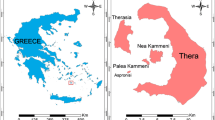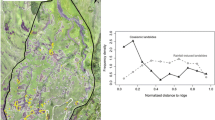Abstract
The 2005 northern Pakistan earthquake (magnitude 7.6) of 8 October 2005 occurred in the northwestern part of the Himalayas. We interpreted landslides triggered by the earthquake using black-and-white 2.5-m-resolution System Pour l’Observation de la Terre 5 (SPOT 5) stereo images. As a result, the counts of 2,424 landslides were identified in the study area of 55 by 51 km. About 79% or 1,925 of the landslides were small (less than 0.5 ha in area), whereas 207 of the landslides (about 9%) were large (1 ha and more in area). Judging from our field survey, most of the small landslides are shallow rock falls and slides. However, the resolution and whitish image in the photos prevented interpreting the movement type and geomorphologic features of the landslide sites in detail. It is known that this earthquake took place along preexisting active reverse faults. The landslide distribution was mapped and superimposed on the crustal deformation detected by the environmental satellite/synthetic aperture radar (SAR) data, active faults map, geological map, and shuttle radar topography mission data. The landslide distribution showed the following characteristics: (1) Most of the landslides occurred on the hanging-wall side of the Balakot–Garhi fault; (2) greater than one third of the landslides occurred within 1 km from the active fault; (3) the greatest number of landslides (1,147 counts), landslide density (3.2 counts/km2), and landslide area ratio (2.3 ha/km2) was found within Miocene sandstone and siltstone, Precambrian schist and quartzite, and Eocene and Paleocene limestone and shale, respectively; (4) there was a slight trend that large landslides occurred on vertically convex slopes rather than on concave slopes; furthermore, large landslides occurred on steeper (30° and more) slopes than on gentler slopes; (5) many large landslides occurred on slopes facing S and SW directions, which is consistent with SAR-detected horizontal dominant direction of crustal deformation on the hanging wall.










Similar content being viewed by others
References
Azad Jammu and Kashmir Government (2006) Statistics of damage done by the earthquake. http://www.ajk.gov.pk/site/index.php?option=com_content&task=view&id=2651&Itemid=153. Cited 2 May 2006
Calkins JA, Offield TW, Abdullah SKM, Ali ST (1975) Geology of the southern Himalaya in Hazara, Pakistan, and adjacent areas. USGS Professional paper 716-C, p 29
Chigira M, Yagi H (2006) Geological and geomorphological characteristics of landslides triggered by the 2004 mid Niigata prefecture earthquake in Japan. Eng Geol 82:202–221
Drewes H (1995) Tectonics of the Potwar Plateau region and the development of syntaxes, Punjab, Pakistan. USGS Bulletin 2126 (22 pp)
Fujiwara S, Tobita M, Sato HP, Ozawa S, Une H, Koarai M, Nakai H, Fujiwara M, Yarai H, Nishimura T, Hayashi F (2006) Satellite data gives snapshot of the 2005 Pakistan earthquake. EOS Transact Am Geograph Union 87:73–77
Geological Survey of Pakistan (1993) Geological map of Pakistan 1:1,000,000
Harp EL, Jibson RW (1996) Landslides triggered by the 1994 Northridge, California earthquake. Bull Seismol Soc Am 86:319–332
Keefer DK (1994) The importance of earthquake-induced landslides to long-term slope erosion and slope-failure hazards in seismically active regions. Geomorphology 10:265–284
Keefer DV (2000) Statistical analysis of an earthquake-induced landslide distribution—the 1989 Loma Prieta, California event. Eng Geol 58:231–249
Lefort P (1975) Himalayas—the collided range. Present knowledge of the continental arc. Am J Sci 275-A:1–44
Nakata T, Tsutsumi H, Khan SH, Lawrence RD (1991) Active faults of Pakistan. Research Center for Regional Geography, Hiroshima University, Japan, p 141
Kumahara Y, Nakata T (2006) Active faults in the epicentral area of the 2005 Pakistan earthquake. Research Center for Regional Geography, Hiroshima University, Japan, p 54
Pakistan Meteorological Department (2006) Earthquake/aftershocks report. http://www.pakmet.com.pk/EQ-Report.html. Cited 2 May 2006
Sato HP, Sekiguchi T, Kojiroi R, Suzuki Y, Iida M (2005a) Overlaying landslides distribution on the earthquake source, geological and topographical data: the mid Niigata prefecture earthquake in 2004, Japan. Landslides 2:143–152
Sato HP, Une H, Koarai M (2005b) Ikonos imagery interpretation on the disaster of northern Pakistan earthquake. http://cais.gsi.go.jp/Research/geoinfo/geoinfo_e.htm. Cited 2 May 2006 (in Japanese)
Space Imaging (2005). http://www.spaceimaging.com/gallery/asiaEQViewer.htm. Cited 2 May 2006
Tobita M, Murakami M, Nakagawa H, Yarai H, Fujiwara S, Rosen PA (2001) 3-D surface deformation of the 2000 Usu eruption measured by matching of SAR images. Geophys Res Lett 28:4291–4294
Tobita M, Nishimura T, Ozawa S, Fujiwara S (2006) Crustal deformation of 2005 northern Pakistan earthquake detected by SAR (2) SAR image matching and 3D deformation map. Abstracts of Japan Geoscience Union Meeting 2006. http://www.jpgu.org/publication/cd-rom/pdf/D124/D124-017_e.pdf. Cited 16 October 2006
USGS Earthquake Hazard Program (2005) Magnitude 7.6—Pakistan-usdyae. http://earthquake.usgs.gov/eqcenter/eqinthenews/2005/usdyae/. Cited 2 May 2006
USGS Earth Resources Observation and Science (2006) Shuttle radar topography mission (SRTM). http://www.edc.usgs.gov/products/elevation.html. Cited 2 May 2006
Wang WN, Wu HL, Nakamura H, Wu SC, Ouyang S, Yu MF (2003) Mass movements caused by recent tectonic activity: the 1999 Chi-Chi earthquake in central Taiwan. Isl Arc 12:325–334
Zevenbergen LW, Thorne CR (1987) Quantitative analysis of land surface topography. Earth Surf Processes Landf 12:47–56
Author information
Authors and Affiliations
Rights and permissions
About this article
Cite this article
Sato, H.P., Hasegawa, H., Fujiwara, S. et al. Interpretation of landslide distribution triggered by the 2005 Northern Pakistan earthquake using SPOT 5 imagery. Landslides 4, 113–122 (2007). https://doi.org/10.1007/s10346-006-0069-5
Received:
Accepted:
Published:
Issue Date:
DOI: https://doi.org/10.1007/s10346-006-0069-5




